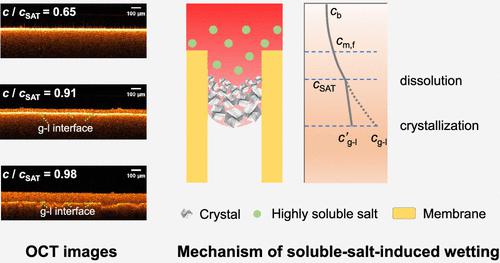当前位置:
X-MOL 学术
›
Environ. Sci. Technol.
›
论文详情
Our official English website, www.x-mol.net, welcomes your
feedback! (Note: you will need to create a separate account there.)
Unique Behaviors and Mechanism of Highly Soluble Salt-Induced Wetting in Membrane Distillation
Environmental Science & Technology ( IF 10.8 ) Pub Date : 2022-09-26 , DOI: 10.1021/acs.est.2c03348 Danting Shi 1 , Tengjing Gong 1 , Weihua Qing 2 , Xianhui Li 3 , Senlin Shao 1
Environmental Science & Technology ( IF 10.8 ) Pub Date : 2022-09-26 , DOI: 10.1021/acs.est.2c03348 Danting Shi 1 , Tengjing Gong 1 , Weihua Qing 2 , Xianhui Li 3 , Senlin Shao 1
Affiliation

|
Scaling-induced wettinggreatly limits the application of membrane distillation (MD) for the desalination of high-salinity feed. Although highly soluble salts (e.g., NaCl) have high concentrations in this water, their scaling-induced wetting remains overlooked. To unravel the elusive wetting behaviors of highly soluble salts, in this study, we systematically investigated the scaling formation and wetting progress by in situ observation with optical coherence tomography (OCT). Through examining the influence of salt type and vapor flux on the wetting behavior, we revealed that highly soluble salt-induced wetting, especially under high vapor flux, shared several unique features: (1) occurring before the bulk feed reached saturation, (2) no scale layer formation observed, and (3) synchronized wetting progress on the millimeter scale. We demonstrated that a moving scale layer caused these interesting phenomena. The initial high vapor flux induced high concentration and temperature polarizations, which led to crystallization at the gas–liquid interface and the formation of an initial scale layer. On the one hand, this scale layer bridged the water into the hydrophobic pores; on the other hand, it blocked the membrane pores and reduced the vapor flux. In this way, the decreased vapor flux mitigated the concentration/temperature polarizations, and consequently led to the dissolution of the feed-facing side of the scale layer. This dissolution prevented the membrane pores from being completely blocked, facilitating the transportation and crystallization of salts at the distillate-facing side of the scale layer (i.e., the gas–liquid interface), thus the proceeding of the wetting layer.
中文翻译:

膜蒸馏中高溶盐诱导润湿的独特行为和机理
结垢引起的润湿极大地限制了膜蒸馏 (MD) 在高盐度饲料脱盐中的应用。尽管高度可溶的盐(例如,NaCl)在水中的浓度很高,但它们的结垢引起的润湿仍然被忽视。为了揭示高可溶性盐难以捉摸的润湿行为,在本研究中,我们通过光学相干断层扫描 (OCT) 的原位观察系统地研究了结垢的形成和润湿过程。通过检查盐类型和蒸汽通量对润湿行为的影响,我们发现高可溶性盐诱导润湿,特别是在高蒸汽通量下,具有几个独特的特征:(1)发生在散装进料达到饱和之前,(2)没有观察到水垢层的形成,并且 (3) 在毫米尺度上同步润湿进程。我们证明了移动比例层导致了这些有趣的现象。初始的高蒸汽通量引起高浓度和温度极化,导致气液界面结晶和初始水垢层的形成。一方面,这个水垢层将水桥接到疏水孔中;另一方面,它阻塞了膜孔并降低了蒸汽通量。通过这种方式,减少的蒸汽通量减轻了浓度/温度的极化,从而导致水垢层面向进料侧的溶解。这种溶解防止了膜孔被完全堵塞,促进了盐在垢层面向馏出物的一侧(即气-液界面)的运输和结晶,
更新日期:2022-09-26
中文翻译:

膜蒸馏中高溶盐诱导润湿的独特行为和机理
结垢引起的润湿极大地限制了膜蒸馏 (MD) 在高盐度饲料脱盐中的应用。尽管高度可溶的盐(例如,NaCl)在水中的浓度很高,但它们的结垢引起的润湿仍然被忽视。为了揭示高可溶性盐难以捉摸的润湿行为,在本研究中,我们通过光学相干断层扫描 (OCT) 的原位观察系统地研究了结垢的形成和润湿过程。通过检查盐类型和蒸汽通量对润湿行为的影响,我们发现高可溶性盐诱导润湿,特别是在高蒸汽通量下,具有几个独特的特征:(1)发生在散装进料达到饱和之前,(2)没有观察到水垢层的形成,并且 (3) 在毫米尺度上同步润湿进程。我们证明了移动比例层导致了这些有趣的现象。初始的高蒸汽通量引起高浓度和温度极化,导致气液界面结晶和初始水垢层的形成。一方面,这个水垢层将水桥接到疏水孔中;另一方面,它阻塞了膜孔并降低了蒸汽通量。通过这种方式,减少的蒸汽通量减轻了浓度/温度的极化,从而导致水垢层面向进料侧的溶解。这种溶解防止了膜孔被完全堵塞,促进了盐在垢层面向馏出物的一侧(即气-液界面)的运输和结晶,









































 京公网安备 11010802027423号
京公网安备 11010802027423号